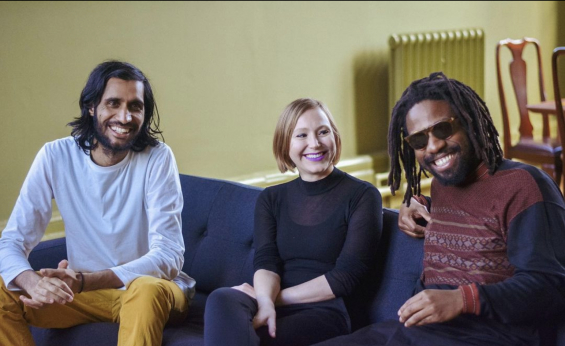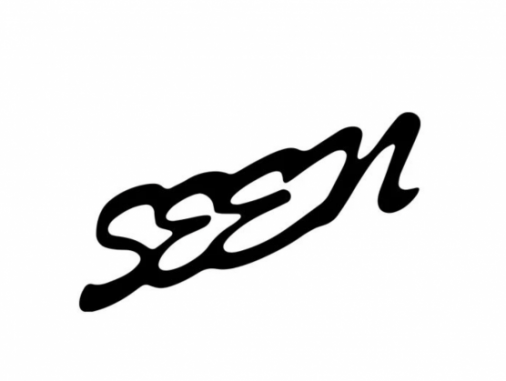Committed to challenging the London-centric narrative pervasive in established electronic music journalism, SEEN Mag is a bold, new culture zine springing from Manchester and the northwest. You can get to the print magazine’s official launch event at 12pm as part of the BOUND Art Book Fair in Manchester’s Whitworth Gallery on 29 October.
Rob Smith chatted to co-founders Kamila, Tunde and Balraj about the titles and writing that have shaped their outlooks on dance music culture, and inspired them to set up the publication.

Did any books stand out as being, not necessarily the first thing you read, but the first thing you remember engaging with?
Tunde: John Agard‘s writing in AQA’s poetry Anthology), oh and my timetables. All very impactful reads in my life where I’ve learned about identity and the maths of life.
Kamila: I was reading books from an early age. When I was at primary school I really enjoyed children’s books about the second world war, about kids who had to be evacuated. Looking back, those stories probably resonated because my grandparents shared a lot of experiences from the war with me and I was always on the move as a child, then me and my mum moved from Poland, where I’m from, to the UK.
Balraj: I’d say similar to Tunde, that anthology of poems definitely stood out. There was a poem about a young South Asian showing their saree to a friend when they’d come over to their house and it being a bit of a disconnect. I felt it showed the duality that a lot of migrant second-generation children go through almost living two different lives at home and at school.
Later studying The Handmaid’s Tale, 1984 and Catch 22 during sixth form were three novels that I remember distinctly engaging with.
If you had to choose three titles to put on a SEEN essentials reading list, what would they be?
T: Grime Kids, The Alchemist, Things Fall Apart. Pretty much summate a point in time for me.
K: I’m really into hip hop and grime, so for me, an essential hip hop book is Nuthin’ but a “G” Thang: The Culture and Commerce of Gangsta Rap (Popular Cultures, Everyday Lives) by Eithne Quinn. More recently, a really important book about how rap lyrics are used in criminal trials in America is Rap on Trial by Erik Nielson and Andrea L. Dennis.
Joy White is an essential writer to read if you’re into grime. For example, her recent Terraformed discusses how structural racism and gentrification have affected grime scenes in Newham in London.
B: That’s a great question and maybe we should put together a SEEN reading list on our site! I feel my three would be Black Star – Britain’s Asian Youth Movements by Anandi Ramamurthy, Cut Short – Why We’re Failing Our Youth – and How to Fix it by Ciaran Thapar and Sisters of the Yam by Bell Hooks.
Black Star is a great account of global majority and marginalised peoples in the UK coming together to form solidarity with causes despite the odds, so I feel it’s a relevant read for SEEN.
Cut Short is a very up-to-the-time account of the failings of the current approach to British education touching on the over-policing of rap/drill music as well as how school exclusions disproportionately affect young pan-African boys. It does also feature hopeful stories and future suggestions too which are welcomed.
Sisters of the Yam is a powerful read it was a contributing factor to wanting to embark on this project with such a lovely team!
Is there anything you haven’t read yet but are looking forward to getting stuck into?
T: All About Love by bell hooks.
K: All About Love is one of my favourite books, so I’ll happily lend that to you Tunde! I’m currently writing a book for Bloomsbury’s 33 ⅓ series so other books in that series are on my reading to-do list.
B: Yes, love that one too Tunde – great choice! I have Bury my Heart at Wounded Knee by Dee Brown up to read next along with Lemn Sissay’s My Name is Why. I’d also like to read Maisie Hill’s Perimenopause Power, the follow-up to her excellent book Period Power.
Have you ever finished a book and then wished that you’d written it?
T: Yes, The Alchemist.
K: All the time.
B: Actually no I don’t think I have! I’m usually wrapped up in the context of the book and perhaps feel I wouldn’t have been able to do it justice as my experience/expertise isn’t the same as the writer’s. But perhaps that may be because the main writing I do is usually short blurbs, press releases and emails these days.
Velocity Press specialises in dance-floor driven literature – any club culture or dance-focused titles that SEEN recommends?
T: Anything your heart desires, you tell me.
K: DJ Paulette, one of our contributors and a good friend of ours is currently writing Welcome To The Club: The Life And Lessons Of A Black Woman DJ, to be published by Manchester University Press in 2023. I can’t wait to read it, especially as it’ll be one of the first books re-writing the history of Manchester club culture, which too often has been dominated by white cis men in how it’s been documented.
Pink Noises by Tara Rogers is also essential reading, in my opinion, being one of the first books to celebrate women in electronic music – I drew on it a lot in my academic writing on women in club culture.
Unfortunately, it’s not been translated into English yet, but 30 Years Of Polish Techno Scene, edited by Radosław Tereszczuk, Łukasz Krajewski and Artur Wojtczak, is a fascinating history of Polish club culture, which often gets underrepresented in the music press and publishing in the west. It has even recently been adapted into a play!
B: Hyped for DJ Paulette’s book to drop! I’d add Run the Riddim: The Untold Story of ’90s Dancehall to the World by Marvin Sparks to this as well as Joe Muggs’ Bass, Mids, Tops and Dan Hancox’s Inner City Pressure.
What, at SEEN, do you feel makes for good music writing?
T: Talking from the heart.
K: A conversation we’ve had when discussing what we wanted SEEN to be, was an onus on people telling their own stories, whether that’s people writing about their own experiences or writing about their own culture.
When commissioning articles for issue one, we really put that into practice and I think it’s made for some great writing. So as Tunde says, talking from the heart.
B: Kamila and Tunde have put this brilliantly.
Others in independent publishing have suggested we’ve hit a post-lockdown zine renaissance, do you agree? Why has SEEN happened now?
T: I’m not sure… think magazines are like scriptures which have always been prevalent. SEEN just wanted to be seen.
B: I think potentially yes there seems to be a resurgence for more print publications and zines. Speaking personally I became fatigued at the amount of digital media during the lockdowns and found myself buying or subscribing to magazines that come through the door every month or two and enjoyed reading them to start the day or flicking through them in the evening.
Things like Burnt Roti, Ethical Consumer, the Black Curriculum zines, Positive News (much needed!). The tangible aspect was welcomed as a break away from Teams, Google Meet and Zoom.
In a way, it’s perhaps why SEEN as a print magazine came to mind, but it was also thinking about the transient and fleeting nature of news cycles and press articles as well as the constraints of digital access.
We want to offer something a little more concrete with a license to delve deeper into a topic as well as set the record straight – so hence the ‘archiving sonics, stories and scenes’ tagline came into being.
Particularly to those outside of club culture, reading and dancing can seem pretty disparate practices, with a stereotype being that ravers don’t read. For you, is there any form of common ground or relationship between dancing and reading? If so, do you think this has changed over time, are the practices more interlinked than they’ve been previously?
T: Of course, you’ve got to read the crowd.
K: I’m not sure magazines such as Mixmag and DJ Mag would have survived so long if ravers didn’t read! There are too many stereotypes about ravers in general that I think we should be trying to challenge, for example, that ravers are only young people.
Ravers, like society in general, are all sorts of different people. I think an obvious comparison between dancing and reading though, is that they’re both forms of escapism.
B: I feel there is a nice crossover with dancing and reading as I met a lot of life-long friends through clubs/raving and the conversations and relationships from those have definitely led to sharing books and article recommendations. Likewise, my older sister definitely was a Mixmag reader and a clubber back in Gatecrasher/Cream Liverpool days!
Often you may have students who are studying in a city who go out and rave and then hit the books too. I feel they’re definitely interlinked but perhaps a little more so given digital connectivity. One thing to avoid is perhaps over-intellectualising or orientalising a scene or sound without centring the voices of the community.
Do you think London’s traditional position as the perceived centre of music, dance and club culture in the UK is beginning to change?
T: People know Manchester as a centre point for life.
K: I think people who live outside of London don’t perceive it to be the centre of music. A city like Glasgow for example, has a very strong identity as a music city, as does Manchester, as do Liverpool, Leeds, and Sheffield. A continued privileging of London-hailing music and club culture in music press and publishing peddles that myth though.
But I do think that’s beginning to change – over the last 5-10 years there’s been an increasing interest in what’s going on outside London in the music press. The way scenes and artists are covered can be problematic though, shoring up tired stereotypes or tropes, such as whatever is going on in Manchester being compared to the Hacienda or Blackpool being characterised as this trashy place with no culture, that’s suddenly got something interesting going on.
When can we expect to see the first issue of SEEN, where can people get their hands on SEEN?
T: @seen_universe.
B: I can say with confidence that it’ll be out for the weekend of 29/30 October where we’ll be at the BOUND Art Book Fair at the Whitworth selling copies! Hope you can pop by.
K: And then on our website and in all your favourite magazine shops, of course.


